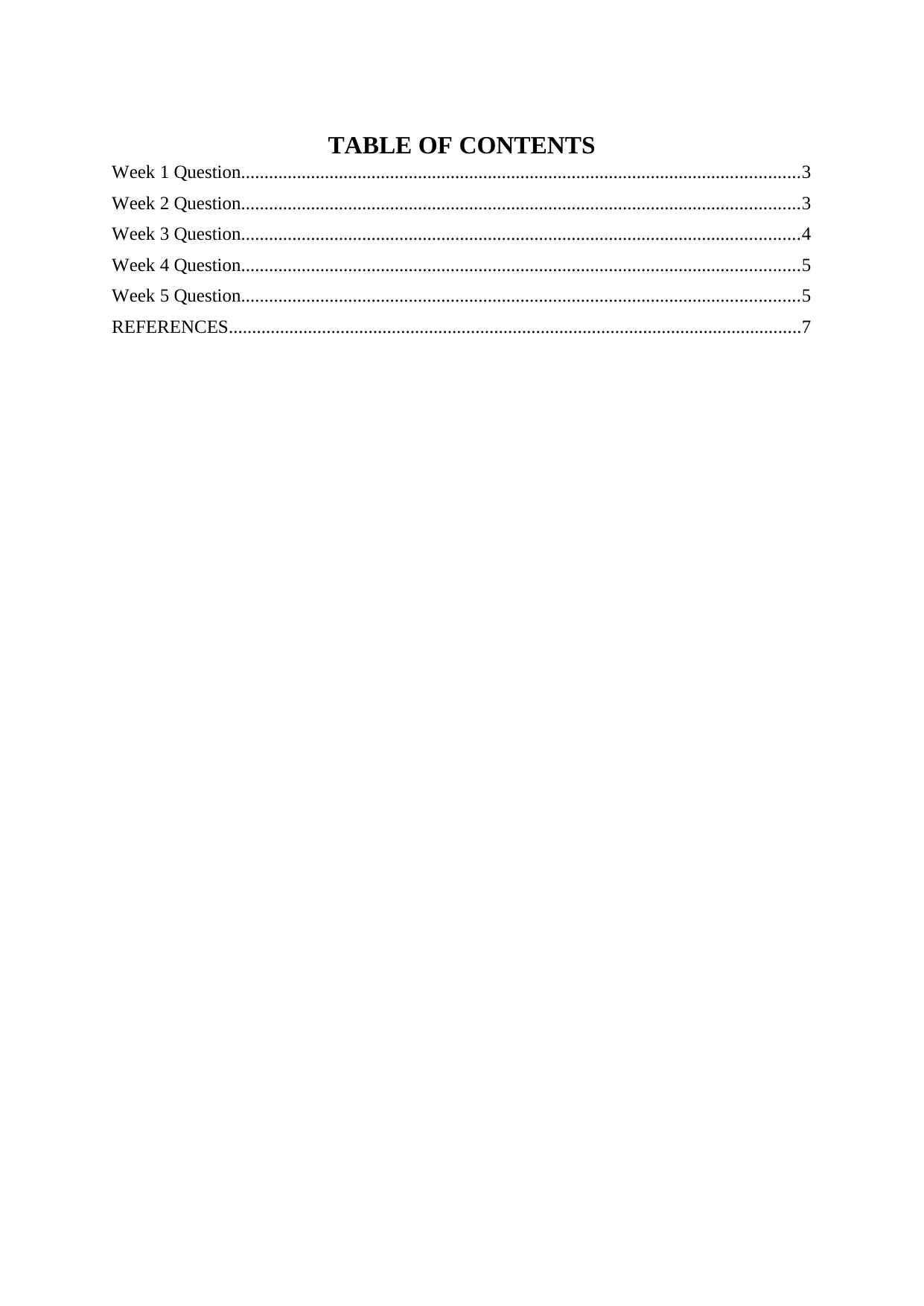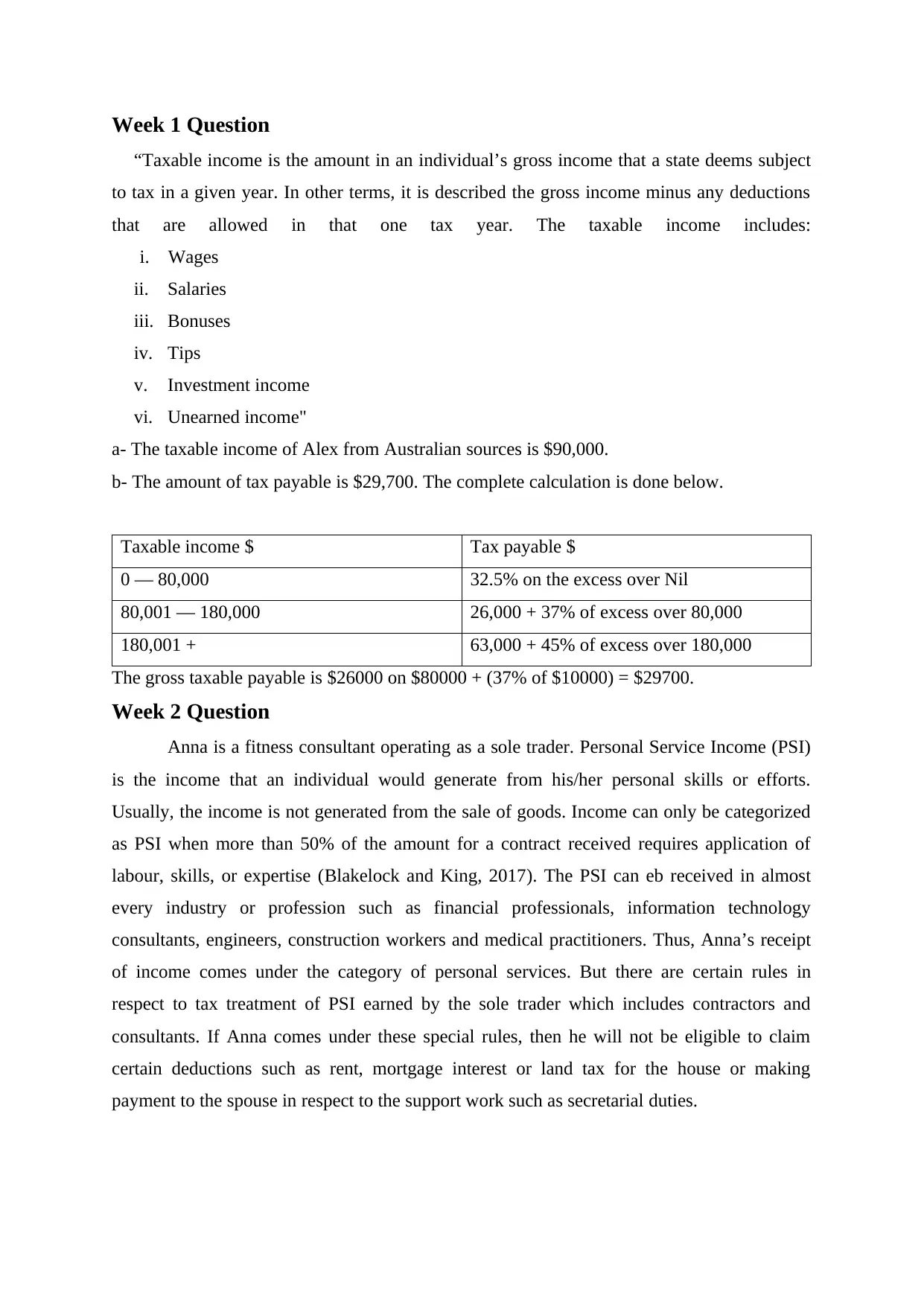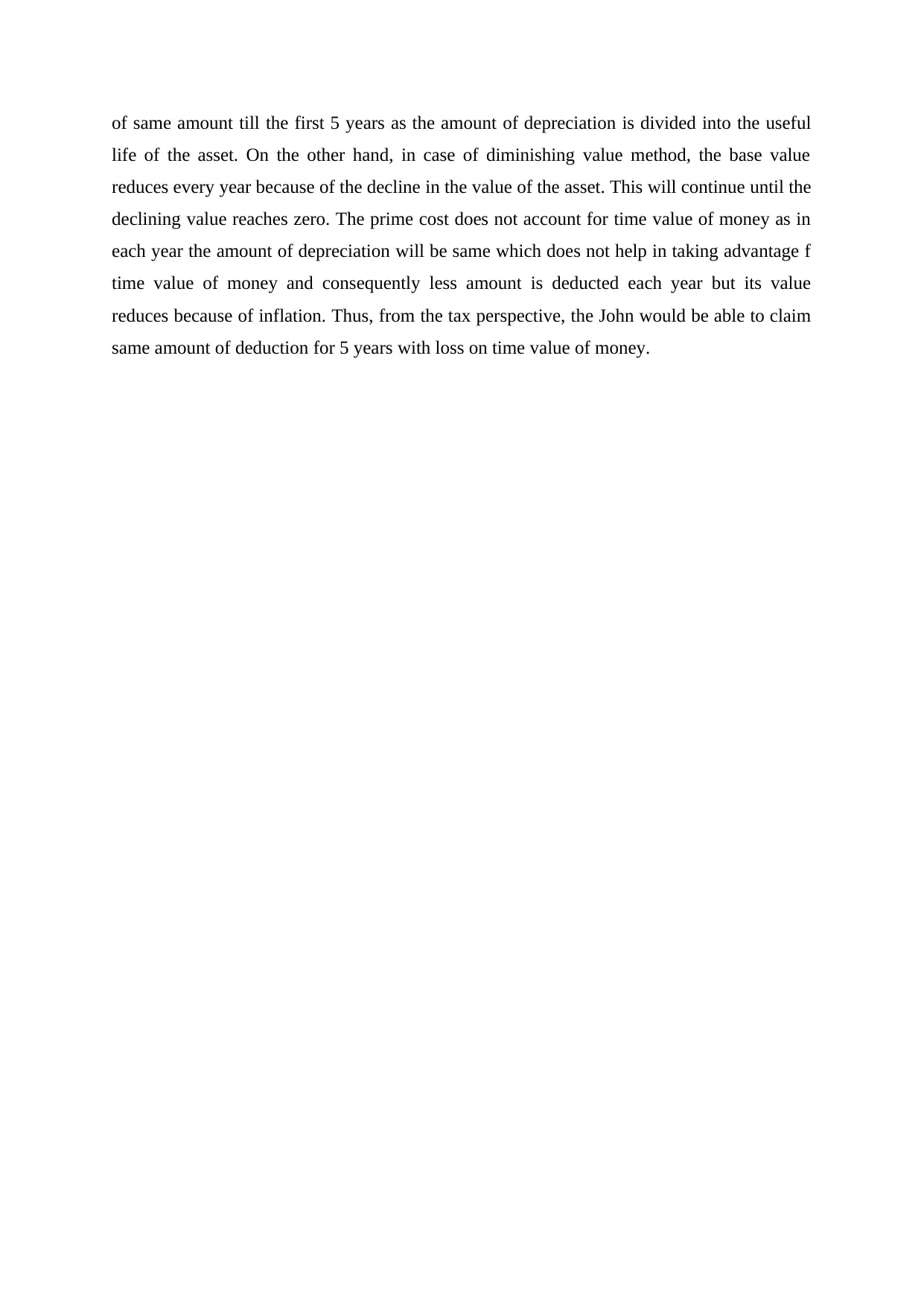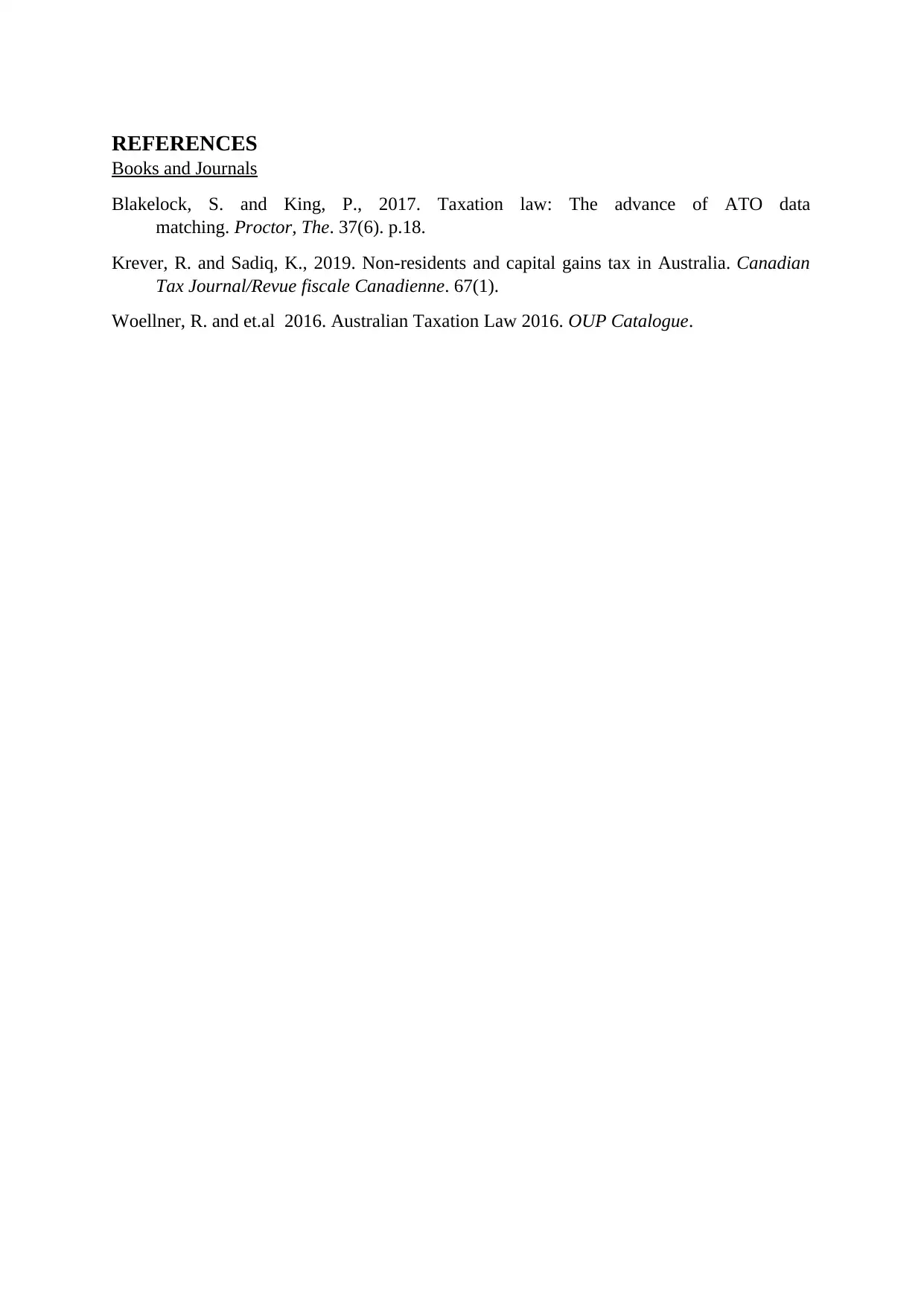Taxation Law Tutorial Questions Assignment HA3042: Weeks 1-5 Analysis
VerifiedAdded on 2023/01/11
|7
|1286
|42
Homework Assignment
AI Summary
This assignment presents solutions to tutorial questions from a Taxation Law unit (HA3042), covering weeks 1 through 5. The content addresses several key aspects of Australian taxation law, including the calculation of taxable income, the tax payable based on income brackets, and the implications of Personal Service Income (PSI) for sole traders like Anna. It further explores capital gains and losses, detailing exemptions for certain assets like a main residence and personal items, along with calculations for capital gains on collectables. Additionally, the assignment examines deductible expenses for rental properties, such as interest and maintenance fees, and contrasts the prime cost method and diminishing value method for depreciation, explaining their impact on tax deductions. The solutions are comprehensive, referencing relevant tax laws and providing practical examples to illustrate the concepts.

Tutorial project
Paraphrase This Document
Need a fresh take? Get an instant paraphrase of this document with our AI Paraphraser

TABLE OF CONTENTS
Week 1 Question........................................................................................................................3
Week 2 Question........................................................................................................................3
Week 3 Question........................................................................................................................4
Week 4 Question........................................................................................................................5
Week 5 Question........................................................................................................................5
REFERENCES...........................................................................................................................7
Week 1 Question........................................................................................................................3
Week 2 Question........................................................................................................................3
Week 3 Question........................................................................................................................4
Week 4 Question........................................................................................................................5
Week 5 Question........................................................................................................................5
REFERENCES...........................................................................................................................7

Week 1 Question
“Taxable income is the amount in an individual’s gross income that a state deems subject
to tax in a given year. In other terms, it is described the gross income minus any deductions
that are allowed in that one tax year. The taxable income includes:
i. Wages
ii. Salaries
iii. Bonuses
iv. Tips
v. Investment income
vi. Unearned income"
a- The taxable income of Alex from Australian sources is $90,000.
b- The amount of tax payable is $29,700. The complete calculation is done below.
Taxable income $ Tax payable $
0 — 80,000 32.5% on the excess over Nil
80,001 — 180,000 26,000 + 37% of excess over 80,000
180,001 + 63,000 + 45% of excess over 180,000
The gross taxable payable is $26000 on $80000 + (37% of $10000) = $29700.
Week 2 Question
Anna is a fitness consultant operating as a sole trader. Personal Service Income (PSI)
is the income that an individual would generate from his/her personal skills or efforts.
Usually, the income is not generated from the sale of goods. Income can only be categorized
as PSI when more than 50% of the amount for a contract received requires application of
labour, skills, or expertise (Blakelock and King, 2017). The PSI can eb received in almost
every industry or profession such as financial professionals, information technology
consultants, engineers, construction workers and medical practitioners. Thus, Anna’s receipt
of income comes under the category of personal services. But there are certain rules in
respect to tax treatment of PSI earned by the sole trader which includes contractors and
consultants. If Anna comes under these special rules, then he will not be eligible to claim
certain deductions such as rent, mortgage interest or land tax for the house or making
payment to the spouse in respect to the support work such as secretarial duties.
“Taxable income is the amount in an individual’s gross income that a state deems subject
to tax in a given year. In other terms, it is described the gross income minus any deductions
that are allowed in that one tax year. The taxable income includes:
i. Wages
ii. Salaries
iii. Bonuses
iv. Tips
v. Investment income
vi. Unearned income"
a- The taxable income of Alex from Australian sources is $90,000.
b- The amount of tax payable is $29,700. The complete calculation is done below.
Taxable income $ Tax payable $
0 — 80,000 32.5% on the excess over Nil
80,001 — 180,000 26,000 + 37% of excess over 80,000
180,001 + 63,000 + 45% of excess over 180,000
The gross taxable payable is $26000 on $80000 + (37% of $10000) = $29700.
Week 2 Question
Anna is a fitness consultant operating as a sole trader. Personal Service Income (PSI)
is the income that an individual would generate from his/her personal skills or efforts.
Usually, the income is not generated from the sale of goods. Income can only be categorized
as PSI when more than 50% of the amount for a contract received requires application of
labour, skills, or expertise (Blakelock and King, 2017). The PSI can eb received in almost
every industry or profession such as financial professionals, information technology
consultants, engineers, construction workers and medical practitioners. Thus, Anna’s receipt
of income comes under the category of personal services. But there are certain rules in
respect to tax treatment of PSI earned by the sole trader which includes contractors and
consultants. If Anna comes under these special rules, then he will not be eligible to claim
certain deductions such as rent, mortgage interest or land tax for the house or making
payment to the spouse in respect to the support work such as secretarial duties.
⊘ This is a preview!⊘
Do you want full access?
Subscribe today to unlock all pages.

Trusted by 1+ million students worldwide

Week 3 Question
Capital gains or losses arise from the sale or exchange of capital assets. Simply stated,
capital losses result when resultant transactions lead to figures that are lower than the original
purchase value capital assets (Woellner and et.al, 2016). Alternatively, capital gains occur
when transactions net amounts greater than the original value at purchase. All the assets that
is acquired on or after 20 September 1985 are subject to capital gain tax with certain
exception.
Some of the assets which are exempted from capital gain or losses which are stated
below.
Main residence with certain exceptions,
Personal car and other motor vehicles,
Items purchased for personal use costing less than $10,000,
Collectables acquired for worth $500 or less,
Depreciating assets utilized for the taxable purpose only and trading stocks,
Assets which are acquired before 20 September 1985,
Decoration awarded for brave conduct,
Asset used in producing exempt income,
Compensation received for injury suffered in the occupation to you or your relatives,
Income from gambling and so forth.
In this case, Alex had acquired an old golden gramophone on 1st June 2000 in terms of
collections. This was not for business purpose as stated. There is certain exemption in respect
to the capital gain or loss from a collectable which are described below.
Collectable acquired for $500 or less,
Any interest is acquired in the collectable for $500 or less before 16 December 1995,
Interest is acquired when it is hade a market value of worth for $500 or less.
Based on all these, it can be said that the Alex’s net capital gain is $2417.
Particulars Amount
Sales proceeds 3000
Less: Index cost of acquisition
(500*116.6/100)
583
Capital gain 2417
Capital gains or losses arise from the sale or exchange of capital assets. Simply stated,
capital losses result when resultant transactions lead to figures that are lower than the original
purchase value capital assets (Woellner and et.al, 2016). Alternatively, capital gains occur
when transactions net amounts greater than the original value at purchase. All the assets that
is acquired on or after 20 September 1985 are subject to capital gain tax with certain
exception.
Some of the assets which are exempted from capital gain or losses which are stated
below.
Main residence with certain exceptions,
Personal car and other motor vehicles,
Items purchased for personal use costing less than $10,000,
Collectables acquired for worth $500 or less,
Depreciating assets utilized for the taxable purpose only and trading stocks,
Assets which are acquired before 20 September 1985,
Decoration awarded for brave conduct,
Asset used in producing exempt income,
Compensation received for injury suffered in the occupation to you or your relatives,
Income from gambling and so forth.
In this case, Alex had acquired an old golden gramophone on 1st June 2000 in terms of
collections. This was not for business purpose as stated. There is certain exemption in respect
to the capital gain or loss from a collectable which are described below.
Collectable acquired for $500 or less,
Any interest is acquired in the collectable for $500 or less before 16 December 1995,
Interest is acquired when it is hade a market value of worth for $500 or less.
Based on all these, it can be said that the Alex’s net capital gain is $2417.
Particulars Amount
Sales proceeds 3000
Less: Index cost of acquisition
(500*116.6/100)
583
Capital gain 2417
Paraphrase This Document
Need a fresh take? Get an instant paraphrase of this document with our AI Paraphraser

Week 4 Question
There are certain deductions that can be claimed only if the expenses are incurred by
the owner and not by the tenant. Expenses that are entitled to deduction from the income
includes-
advertising for tenants
body corporate fees and charges
council rates
water charges
land tax
cleaning, gardening and lawn mowing
pest control and insurance (building, contents, public liability)
interest expenses
pre-paid expenses
property agent's fees and commission
repairs and maintenance
other legal expenses
In respect to interest expenses, if the loan is taken for buying the rental property in that
case deduction for the interest charged on loans can be claimed either in full or in some
portion. However, it is essential that the property must be rented or is available for rent on
actual basis in the income year in which deduction is claimed. Also, for repairs and
maintenance, deduction can be claimed in the year it is incurred. It can eb claimed if it is
directly related to the wear and tear which occurs as a result of renting out the property.
Thus, both bank interest charges and maintenance fees paid to William can be claimed as
deduction by Sam.
Week 5 Question
The prime cost method is also known as the straight-line method of providing
depreciation. It assumes that the value of assets decreases at uniform rates over time.
Irrespective of the method used for depreciation, the decline in value of the asset is reduced
by the purpose when it is not used for non-taxable purpose. In the case, machinery is used
90% for the business purpose (Krever and Sadiq, 2019). Thus, decline in the value will be
reduced by 10%. In terms of taxation, using the prime cost method, John can claim deduction
There are certain deductions that can be claimed only if the expenses are incurred by
the owner and not by the tenant. Expenses that are entitled to deduction from the income
includes-
advertising for tenants
body corporate fees and charges
council rates
water charges
land tax
cleaning, gardening and lawn mowing
pest control and insurance (building, contents, public liability)
interest expenses
pre-paid expenses
property agent's fees and commission
repairs and maintenance
other legal expenses
In respect to interest expenses, if the loan is taken for buying the rental property in that
case deduction for the interest charged on loans can be claimed either in full or in some
portion. However, it is essential that the property must be rented or is available for rent on
actual basis in the income year in which deduction is claimed. Also, for repairs and
maintenance, deduction can be claimed in the year it is incurred. It can eb claimed if it is
directly related to the wear and tear which occurs as a result of renting out the property.
Thus, both bank interest charges and maintenance fees paid to William can be claimed as
deduction by Sam.
Week 5 Question
The prime cost method is also known as the straight-line method of providing
depreciation. It assumes that the value of assets decreases at uniform rates over time.
Irrespective of the method used for depreciation, the decline in value of the asset is reduced
by the purpose when it is not used for non-taxable purpose. In the case, machinery is used
90% for the business purpose (Krever and Sadiq, 2019). Thus, decline in the value will be
reduced by 10%. In terms of taxation, using the prime cost method, John can claim deduction

of same amount till the first 5 years as the amount of depreciation is divided into the useful
life of the asset. On the other hand, in case of diminishing value method, the base value
reduces every year because of the decline in the value of the asset. This will continue until the
declining value reaches zero. The prime cost does not account for time value of money as in
each year the amount of depreciation will be same which does not help in taking advantage f
time value of money and consequently less amount is deducted each year but its value
reduces because of inflation. Thus, from the tax perspective, the John would be able to claim
same amount of deduction for 5 years with loss on time value of money.
life of the asset. On the other hand, in case of diminishing value method, the base value
reduces every year because of the decline in the value of the asset. This will continue until the
declining value reaches zero. The prime cost does not account for time value of money as in
each year the amount of depreciation will be same which does not help in taking advantage f
time value of money and consequently less amount is deducted each year but its value
reduces because of inflation. Thus, from the tax perspective, the John would be able to claim
same amount of deduction for 5 years with loss on time value of money.
⊘ This is a preview!⊘
Do you want full access?
Subscribe today to unlock all pages.

Trusted by 1+ million students worldwide

REFERENCES
Books and Journals
Blakelock, S. and King, P., 2017. Taxation law: The advance of ATO data
matching. Proctor, The. 37(6). p.18.
Krever, R. and Sadiq, K., 2019. Non-residents and capital gains tax in Australia. Canadian
Tax Journal/Revue fiscale Canadienne. 67(1).
Woellner, R. and et.al 2016. Australian Taxation Law 2016. OUP Catalogue.
Books and Journals
Blakelock, S. and King, P., 2017. Taxation law: The advance of ATO data
matching. Proctor, The. 37(6). p.18.
Krever, R. and Sadiq, K., 2019. Non-residents and capital gains tax in Australia. Canadian
Tax Journal/Revue fiscale Canadienne. 67(1).
Woellner, R. and et.al 2016. Australian Taxation Law 2016. OUP Catalogue.
1 out of 7
Related Documents
Your All-in-One AI-Powered Toolkit for Academic Success.
+13062052269
info@desklib.com
Available 24*7 on WhatsApp / Email
![[object Object]](/_next/static/media/star-bottom.7253800d.svg)
Unlock your academic potential
Copyright © 2020–2025 A2Z Services. All Rights Reserved. Developed and managed by ZUCOL.




